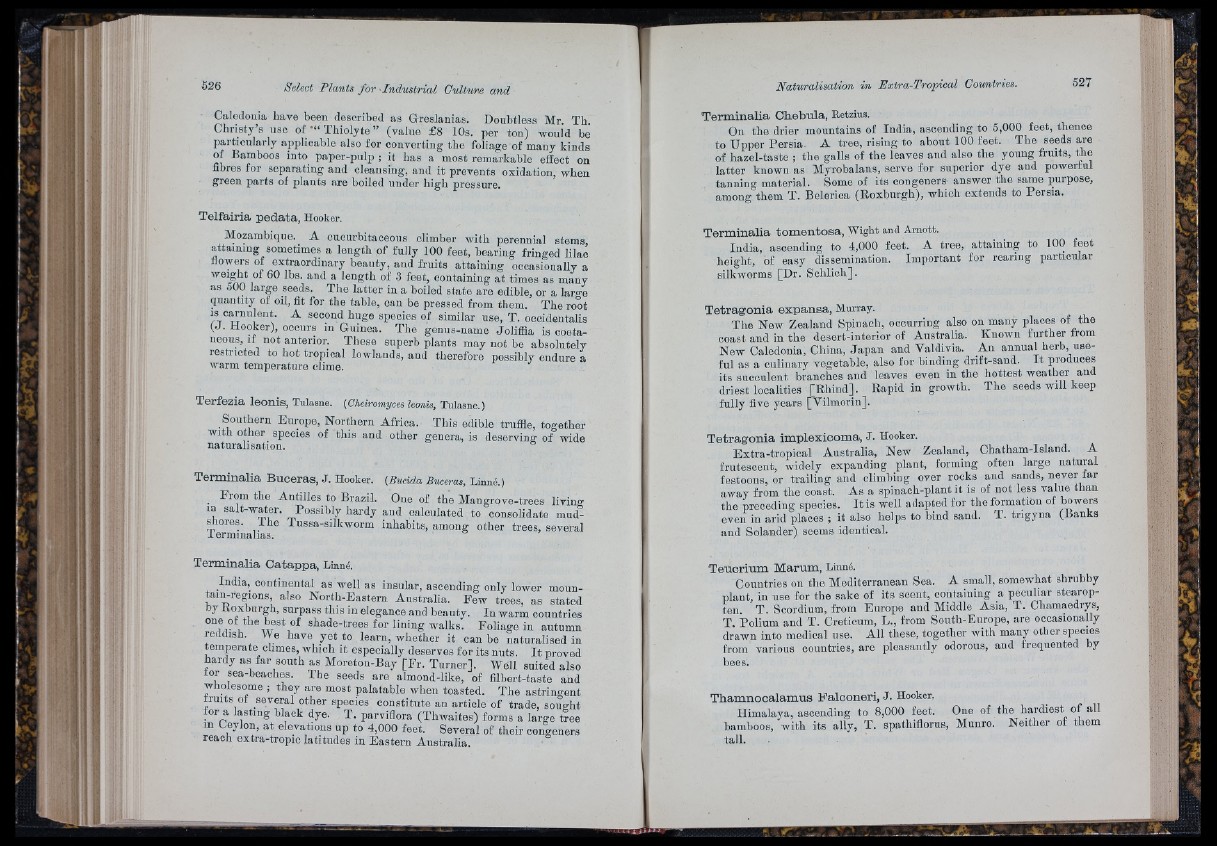
Caledonia have been described as Greslanias. Doubtless Mr. Th.
Christy’s nse o f Th i o l y t e ” (value £8 10s. per ton) would be
particularly applicable also for converting the foliage of many kinds
of Bamboos into paper-pulp ; it has a most remarkable effect on
fibres for separating and cleansing, and it prevents oxidation, when
green parts of plants are boiled under high pressure.
Telfairia pedata, Hooker.
Mozambique. A cucnrbitaoeous climber with perennial stems,
attaining sometimes a length of fully 100 feet, bearing fringed lilac
flowers of extraordinary beauty, and fruits attaining occasionally a
Aveight of 60 lbs. and a length of 3 feet, containing a t times as many
as 500 large seeds. The la tte r in a boiled state are edible, or a large
quantity of oil, fit for the table, can be pressed from them. The root
IS carnulent. A second huge species of similar use, T. occidentalis
(J . Hooker), occurs in Guinea. The genus-name Joliffia is coeta-
iieous, if not anterior. These superb plants may not be absolutely
restricted to hot tropical lowlands, and therefore possibly endure a
warm temperature clime.
Terfezia leonis, Tulasne. {Cheiromyces leonis, Tulasne.)
Southern Europe, Northern Africa. This edible triifHe, together
with other species of this and other genera, is deserving of wide
naturalisation.
Terminalia Buceras, J. Hooker. {Bucida Buceras, Linné.)
_ From the Antilles^ to Brazil. One of the Mangrove-trees living
la salt-water. Possibly hardy and calculated to consolidate mud-
shores. The Tussa-silkworm inhabits, among other trees, several
lerminalias.
Terminalia Catappa, Linné.
India, continental as well as insular, ascending only lower mountain
regions also North-Eastern Australia. Few trees, as stated
by Roxburgh, surpass this in elegance and beauty. In warm countries
one ot the best of shade-trees for lining walks. Foliage in autumn
reddish. We have yet to learn, whether it can be naturalised in
temperate climes, which it especially deserves for its nuts. I t proved
^ r d y as far south as Moreton-Bay [F r. Turner]. Well suited also
tor sea-beaches. The seeds are almond-like, of filbert-taste and
wholesome ; they are most palatable when toasted. The astringent
truits ot several other species constitute an article of trade, sought
for a lasting black dye. T. parviflora (Thwaites) forms a large tree
m Ceylon, a t elevations up to 4,000 feet. Several of their congeners
reach extra-tropic latitudes in Eastern Australia.
T e rm in a l i a C h e b u la , Retzius.
On the drier mountains of India, ascending to 5,000 feet, thence
to Upper Persia. A tree, rising to about 100 feet. The s e ^ s are
of hazel-taste ; the galls of the leaves and also the young fruits, the
latter known as Myrobalans, serve for superior dye and powerful
tanning material. Some of its congeners answer the same purpose,
among them T. Belerica (Roxburgh), which extends to Persia.
T e rm in a l ia to m e n to s a , W ight and Arnott.
India, ascending to 4,000 feet. A tree, attaining to 100 feet
height, of easy dissemination. Important for rearing particular
silkworms [Dr. Schlich].
T e t r a g o n i a e x p a n s a , Murray.
The New Zealand Spinach, occurring also on many places of the
coast and in the desert-interior of Australia. Known further from
New Caledonia, China, Ja p a n and Valdivia. An annual herb, useful
as a culinary vegetable, also for binding drift-sand. I t produces
its succulent branches and leaves even iu the hottest weather and
driest localities [Rhind]. Rapid in growth. The seeds will keep
fully five years [Vilmorin].
T e t r a g o n i a im p le x io om a , J. Hooker.
Extra-tropical Australia, New Zealand, Chatham-Island. A
frutescent, widely expanding plant, forming often large natural
festoons, or trailing and climbing over rocks and sands, never tar
away from the coast. As a spinach-plant it is of not less value than
the preceding species. I t is well adapted for the formation of Riwers
even in arid places ; it also helps to bind sand. T. trigyna (Banks
and Solander) seems identical.
T e t i c r iu m M a rum , Linné.
Countries on the Mediterranean Sea. A small, somewhat shrubby
plant, in use for the sake of its scent, containing a peculiar stearopten.
T. Scordium, from Europe and Middle Asia, T. Chamaedrys,
T. Polium and T. Creticum, L., from South-Europe, are occasionally
drawn into medical nse. All these, together with many other species
from various countries, are pleasantly odorous, and frequented by
bees.
T h am n o o a l am u s F a lc o n e r i, J. Hooker.
Himalaya, ascending to 8,000 feet. One of the hardiest of all
bamboos, with its ally, T. spathiflorns, Munro. Neither of them
tall.